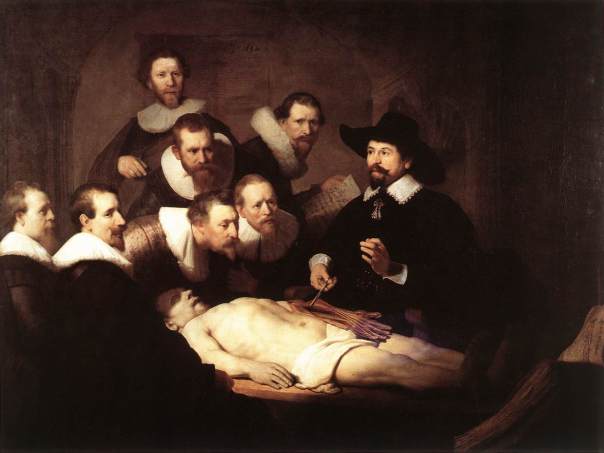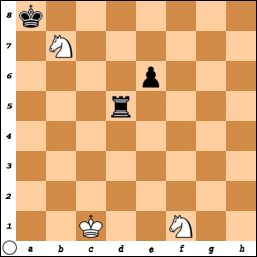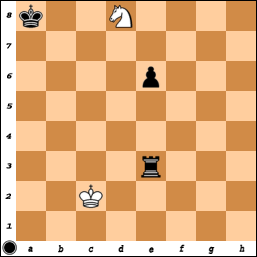Blog Archives
Contact Chess – Martial Art of Mind. Anatomy of a Fight
Can you believe your eyes – this is supposed to be a draw!
At first sight, seems that by no stretch of imagination can White survive here.
Yet, by help of the “contacts theory”, piece coordination and the grand scheme of chess hierarchy presented before, we will be able to dissect the position into discrete elements to get an understand on what’s going on here and how a draw is possible. This might also help you assess the merits and applicability of the “contacts theory” I am speaking up for on this blog.
Take another look at this study of supreme elegance by Mark Savelevich Liburkin (1910-1953). The white pieces are not active and look totally uncoordinated, some on the edge of the board, and yes, the white b7-Knight has no way out. One of the Knights must go. It’s beyond imagination that White may hold in this position against an active black Rook and a Pawn seemingly ready to march its way to the glory, possibly supported by its monarch.
But how can White create any chances here as his position looks completely lost? Perhaps the only one may be to pose threats to the black Pawn together with a combined King’s action (at least the black King is poorly placed in the corner and out of play for now). But again, it’s still hard to imagine survival is possible here at all.
1. Nf1-e3 Although attacked black Rook must lose control over some b7-Knight’s escape squares now, after
1. … Rd5-d3 double attack (C1 on our Grand scheme, or GS:C1) is established on both Knights which guarantees the prey (one of the Knights) still cannot escape.
2. Kc1-c2! Forcing the black Rook to dispatch the e3-Knight. That’s exactly what White wanted to as the b7-Knight is in a more favorable position to attack the e6-Pawn – just one move away. What kind of contact is it? Threat of attack (GS:B2)
2. … Rd3xe3 One Knight is gone – it’s martyred for the fatherland (“dlya Rodinu”, as the Russian would say…)
3. Nb7-d8!! Fantastic!
Now we see more clearly why White gave out the e3-Knight. The Rook is cunningly lured on the e-file (it’s the “drive-on” tactical device, GS:D2) in front of the Pawn where its mobility is reduced (GS:E2-i) and where it can be attacked.
Let’s do some anatomy and check elementary contacts (GS:B), as they always provide clue about the position:
a) the d8-Knight is attacking (GS:B1) the black Pawn,
b) the black Rook is tied down to protecting the Pawn (GS:B3) and is limited to only five squares on the e-file (e1-e5),
c) the Rook is under a threat of attack (GS:B2) from the white King which is one-move away from beginning to harass it by stepping on the d-file,
d) the black King is restricted (GS:B4) by the Knight (at b7) and tactically (at a7 and b8), which foils any attempt to get out of the corner.

Rembrandt van Rijn (1606 - 1669). The Anatomy Lesson of Dr. Nicolaes Tulp, 1632, Mauritshuis, The Hague
We finally realize the two black pieces are actually subjected to a double attack (GS:C2) consisting of the Knight’s attack (GS:B1) on the e6-Pawn, and King’s series of perpetual attacks and threats of attack (GS:B2) the Rook cannot escape as it’s tied down to protecting the e6-Pawn. This is an example of effective piece cooperation (GS:C, “the main principle that runs throughout”, Capablanca) between the King and the Knight.
In contrast, the black troops are uncoordinated and all heavily restricted which reduces their fighting potential. All this explains why, with little help of tactics (GS:D), the draw is possible!
(Now you can also see why studying endings may dramatically improve your chess as full potential of pieces and cooperation between them are lucidly expressed.)
Back to our position. The white King actually wants to be able to attack the Rook whenever it gets on e1, e2, e3, or e4 (it’s well known that King is more gifted at close-range fight than Rook). If the Rook lands on e5, the King simply steps back on the c-file from which it can keep a threat of attack (from say c3-square).
At the same time, on c3 the King is safe as it’s off of the d-file along which the Rook can strike (Re5-d5+) with a double attack winning the d8-Knight.
And lastly, with the Rook on e5, Black is entirely held down really. The Pawn is obviously blocked, but important thing is that the black King cannot get out of the corner and join the fray because of another double attack hanging in the air, this time Nd8-c6 fork (an example of tactical piece cooperation, GS:C4).
3. …Re3-e2+ If 3…e5, then 4.Nf7 maintaining the attack on the e-Pawn and the Rook is unable to avoid King’s attacks coming from the d-file, or if it leaves the e-file, the loss of the Pawn.
4. Kc2-d3 Re3-e1
5. Kd3-d2 Re1-e4
6. Kd2-d3 Re4-e5
7. Kd3-c3! This subtle move keeps the status-quo (see the comment after move 3). The Black can only try:
7. … Re5-c5 to improve his position, but after
8. Kc3-b4 is forced to turn back to e-file. DRAW!
Sheer beauty! Isn’t it?
And here’s the author of this brilliance:
As you’ve seen, we covered a lot of elements from the Grand scheme of hierarchy in chess.
Hope it helped increase your enjoyment of this magnificent piece of chess art.
___________________________________________________________________________________
Comments and suggestions welcome.
I give a 30-minute free consultation on how to get started in chess most effectively to get your game on the fast track. Forget about a boring and confusing 30-page introduction with all those rules on how pieces move, en-passant, 50-move draw, threefold repetition etc. every chess book starts with.
Let’s go right away to the heart and core of the whole chess thing…
You may contact me at iPlayooChess(at)gmail(dot)com
Follow @chessContactChess Structure of Hierarchy Levels [originally: How to Build a Better Chess Teacher?]
Why early teaching in chess seems to be so inefficient?
Case in point. Remember the game from the previous post? 1.e4 d5 2.Bd3 Bg4 3.exd5 Bxd1, where both players had been in a chess school program for more than a year?!
What is better teaching?
And how to build a better chess teacher anyway as there is no such thing as a bad learner?
The learner is always as good as we give them the chance to be. (Remember that the human brain is the most powerful learning machine in the known universe. While computer is a moron, your brain is the most amazing thing in so many ways. Stick to it. Use it. Don’t rely on technology which just is to serve you and your brain to make smarter decisions)
How does the Grand Scheme of Hierarchy in Chess Come to Life?
Let’s take a look at the hierarchy of various functional levels in chess in a bit more detail. Below five levels are defined, from basic pieces effects (A) and basic piece contacts (B) to piece cooperation (C) and tactics and strategy (D-E).
More attention is given to Levels (A), (B) and (C), in contrast with Levels (D) and (E) that are quite extensively covered in chess manuals and publications. Surprisingly, the basic levels are so important to teaching chess, yet one can find very little on the topic (go Google and check out for yourself).
The key to put the beginner on the fast track and start developing a strong board vision is mastering (A) and (B) levels. It’s the alphabet of chess on which the entire edifice rests upon. You can’t build up knowledge on shaky foundations.
Breaking things down this finely into the elementary contacts is indispensable before moving on, ensuring an effective start and better understanding at the micro-level for the unconscious primitive brain. It’s like the foundation of a house – it’s below the surface. And if you want a loftier building, the deeper must the foundation be laid.
Learning is like a ladder. If you miss a step, sometimes you can’t go on. Then you start losing confidence and you simply give up. That’s how chess has been losing a lot of people.
Again, we need to break chess down to its component parts first and build them back up. More than anything else, we love success. As we grow more confident, as we get more excited, we request harder challenges. We love getting to higher levels, like in video games. That way hierarchies emerge and develop. That’s how we become experts.
 Hierarchy of chess. Shaky or steady? Dream world, by Jacek Yerka
Hierarchy of chess. Shaky or steady? Dream world, by Jacek Yerka
Some layers below overlap across levels. For example, the piece coordination (C) may well be seen as stretching across multiple levels, from level (B), as protecting contact (B3), then all across levels (D) and (E).
I’d like to put up a call to readers for feedback on what follows, so we together may come up with the best possible scheme of hierarchy in chess.
A. BASIC PIECE EFFECTS
1. Control (power) effect
The effect by which pieces and pawns exert their power over the board
2. Body effect
The effect chessmen produce by mere occupation of squares on the board which reduces the power, activity and mobility of other pieces, both friendly and enemy ones.
3. Rule of capture
B. ELEMENTARY BOARD CONTACTS
The basic contact are made between chessmen of both sides, as well as chessmen and squares. It’s mere geometry, we just need to see and identify two points on the same straight line. It can’t be simpler than that.
This is the critical level for getting on the fast track and to guarantee an effective learning experience in chess. It gives the unconscious brain the meaning of how pieces interact and what roles they have in the chess conflict. Yet, this level seems to be mostly non-existent in early stages the way we teach chess now. And this is where the secret lies in how to modernize chess education to make it more successful for the 21-st century.
Once these basics are mastered by the subconscious brain and have become its second nature, you no more think about it. It stays under the surface allowing your brain to unleash its full potential elsewhere. Your chess vision is now strong and you are stepping into the realm of creativity, intuition and imagination. The most sophisticated and powerful tools of the power brain.
In the parentheses is the number of pieces involved in each elementary contact:
1. Attack, or attacking contact (2)
Contact established between a piece (or pawn) and another enemy unit in its line of fire (this is actually the only contact existing in chess – stay tuned for an upcoming post – but it is more efficient for human brain to talk roles of pieces, such as attacking, protecting, blocking, etc.)
2. Threat of attack (2)
Indirect, concealed attack, or the attack which is one-move away. GM Averbakh considers the threat of attack as one of elementary contacts – it is important to be aware of how enemy attack develops over time and see things coming as it gives you more time to react appropriately and put up your defenses in time
3. Protection (2)
Contact between friendly pieces for mutual support (friendly pieces kind of “attacking” each other)
4. Restriction (2)
Develops when both friendly or enemy units are lying in the line of fire of a piece, thus reducing its activity and mobility. Also between a piece and the squares within its scope of action when these squares are attacked by hostile troops
5. Blocking (3)
Occurs when one pieces is attacked and another friendly chessman shields it by stepping in the line of fire of an enemy piece. This is also known as the pin and may be considered as a combined contact, or double attack consisting of a direct attack on the pinned, or blocking piece and the threat of attack on the piece behind it lying on the same line of attack
6. Promotion square contact (2)
Contact pawns make with the promotion square
C. PIECE HARMONY/COORDINATION
“The main thing is the coordination of pieces, and this is where most players are weak. Many try to attack with one piece here and another piece there without any concerted action, and later they wonder what is wrong with their game. You must coordinate the action of your pieces, and this is a main principle that runs throughout“, Capablanca, My Chess Career.
1. Double attack
This term is broader than a “two-fold attack” where two pieces directly attack. It covers all various ways of attacking and threats of attack, even the combination of two threats (for example, the most famous K+P vs K+P study in chess by Reti w:Kh8, Pc6/b:Ka6, Ph5 is actually double attack consisting of two threats of second order, or two moves away, one being the threat to catch the h-pawn getting in its Berger’s square, the other being the threat to support white Pawn for promotion). Anything from direct attack to strong threats, including mate threats, stalemating and perpetual check threats may constitute a double attack. Basically, double attack can be of two flavors:
1a. Concentrated attack when two or more pieces are attacking/threatening the same target: a square, or an enemy piece.
“There is no higher and simpler law of strategy than that of keeping one’s forces concentrated. In short, the first principle is: act with the utmost concentration”, Carl Von Clausewitz, On War.
1b. Multi-target attack . One piece, or pawn is attacking two enemy units (fork), or two pieces are attacking two or more targets (discovered attack).
The multi-target approach has obvious merits – instead of striving for single targets, strategy simultaneously aims at multiple aiming points. Very rarely can the opponent defend multiple targets successfully.
2. Combined attack
Coordinated attack against hostile army where one piece or pawn is attacking, while the other pieces of the attacking army restrict freedom of movement of the side under attack.
Averbakh points out that all chess combinations basically depend on double and/or combined attacks.
3. Protection
This is mutual protection established between friendly units, basically the same as the basic protecting contact (B3)
4. Tactical cooperation
The three ways of piece coordination above are relatively simple. However, the coordinated action may be less obvious and show itself in a more or less complex set-up. Tactical coordination may be quite complex and disguised in the form of an indirect attack or protection of a key square. Here is a simple example of the tactical cooperation.
At first sight, the white pieces are dispersed and not well coordinated. But tactical coordination helps one of the pawns get promoted without the white King helping out. For example, 1. g5 Kf5 2.c5! and so on.
5. Strategic cooperation
Let’s use an example to demonstrate:
White’s strategic plan aims at creating an outpost at d5 for the Knight. Strategic coordination here is ensured by coordinated action of white Bishops in two different directions with the idea of removing defenders of d5-square (exchanges at c4 and f6) with its consequent occupation by white Knight.
14.Bxc4! Qxc4 15. Bg5! Rfe8 16.Bxf6! Bxf6 17.Nd5 and White created a strong outpost in the center which would soon serve for a direct attack on the black King.
D. TACTICS
The tactical devices are well-known. Some are listed here:
1. Double attack (pin, skewer, discovered attack are all forms of double attack)
2. Drive-on (attraction)
With the aid of this tactical device a piece (or pawn) is pulled onto a particular square (the motives behind the operation may vary)
3. Drive-off (decoy)
A tactical device that forces the opponent’s piece or pawn to leave its position and give access to an important square (or line)
4. Removing the defender
5. Square and line clearing
6. Line closing and blocking
7. Giving over the right of move (zugzwang) etc.
8. Perpetual attack
E. STRATEGY
The main principle of strategy is to forestall the enemy plans. Whatever they try to do in the battle, you need to see it in advance, frustrate it from the onset, make it of no use for them and suppress it. Once enemy pieces under (some) restraint, you achieve the freedom and activity for your men to be able to gain some advantage and prevail.
A few other major strategic ideas are given below:
0. Selection and maintenance of strategic aim
1. Effective mobilization of pieces and central pawns (in the opening)
2. Improving position of pieces
Means increasing qualitative value of pieces, such as:
i. Mobility (freedom of movement)
ii. Activity (occupation of the center, important squares, open lines)
iii. Stability (vulnerability) of pieces on their posts
iv. Vicinity to critical battlefield sectors
v. Cooperation with other team members (see (C))
3. Stalling the enemy plans to achieve (2) above
4. Exchange of pieces
Trading your “bad” pieces for the enemy “good” ones.
“The process of chess is based essentially on interlinking exchanges. The objective of these interlinking exchanges is a relative gain of material or positional value. There are no other and cannot be any other objectives. At the end of the game these exchanges must lead to a gain of infinitely large magnitude (to checkmate)”, Mikhail Botvinnik
5. Strengthening the position
a. Creating strong points and their protection, and
b. Protecting or eliminating weaknesses in your position are important strategic tasks.
There may even be few weak points in your position, but without strong points no position can hold. You should always act from the position of strength. It’s your-strengths-against-their-weaknesses game as in any struggle, or conflict.
6. Weakening of the enemy position
7. Eliminating the opponent’s counter play, etc.
* * *
Again, I put up a call to you, the reader, for feedback on this. We must change things for true progress in how we teach chess. We need to bring more people to this wonderful absorbing game. But that’s impossible with rotten teaching we have in place.
No more 1.e4 d5 2.Bd3 Bg4 3exd5 Bxd1 games!
We can do better than that!
___________________________________________________________________________________
Comments and suggestions welcome.
I give a 30-minute free consultation on how to get started in chess most effectively to get your game on the fast track. Forget about a boring and confusing 30-page introduction with all those rules on how pieces move, en-passant, 50-move draw, threefold repetition etc. every chess book starts with.
Let’s go right away to the heart and core of the whole chess thing…
You may contact me at iPlayooChess(at)gmail(dot)com
Follow @chessContact




